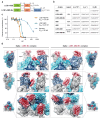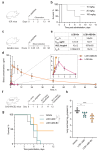Fusion of SARS-CoV-2 neutralizing LCB1 peptide with Bacillus amyloliquefaciens RNase improves antiviral efficacy
- PMID: 40744985
- PMCID: PMC12313848
- DOI: 10.1038/s41598-025-12444-2
Fusion of SARS-CoV-2 neutralizing LCB1 peptide with Bacillus amyloliquefaciens RNase improves antiviral efficacy
Abstract
Virus-neutralizing peptides (VNPs) emerged as promising antiviral drug candidates with unprecedented specificity and cost-effectiveness during the recent COVID-19 pandemic. However, limited avidity, lack of effector functions, short circulatory half-life, and restricted administration routes make them inferior compared to neutralizing antibodies. To address these constraints, a potent VNP that targets the SARS-CoV-2 S protein is combined with Barnase, a highly active RNA-cleaving enzyme from Bacillus amyloliquefaciens. The resulting LCB1-Barnase (LCB1-Bn) chimera retains strong binding affinity for the SARS-CoV-2 S protein and demonstrates a fourfold reduction in IC50 compared to the LCB1 peptide alone in competitive ELISA and in in vitro neutralization tests. In transgenic CAG-hACE2 mice infected with wild-type SARS-CoV-2, intranasal administration of LCB1-Bn significantly improves survival and reduces viral load by 29-fold. To extend circulation life and allow systemic intravenous administration, an albumin-binding domain (ABD) from Streptococcus protein G is added to LCB1-Bn, producing LCB1-ABD-Bn fusion protein which displays a 95-fold increase in serum half-life. LCB1-ABD-Bn exhibits good tolerability at doses below 10 mg/kg and provides protection of SARS-CoV-2-infected CAG-hACE2 animals in 24-hour post-infection intraperitoneal treatment. Cryo-EM reveals the LCB1-ABD-Bn's tight interaction with S protein RBD domains, highlighting its potential as a promising drug candidate against SARS-CoV-2.
Keywords: Antiviral peptide; Barnase; Half-life extension; Pharmacokinetics; SARS-CoV-2; Virus neutralizing peptides (VNPs).
© 2025. The Author(s).
Conflict of interest statement
Declarations. Competing interests: The authors declare no competing interests.
Figures





Similar articles
-
Limited Variation between SARS-CoV-2-Infected Individuals in Domain Specificity and Relative Potency of the Antibody Response against the Spike Glycoprotein.Microbiol Spectr. 2022 Feb 23;10(1):e0267621. doi: 10.1128/spectrum.02676-21. Epub 2022 Jan 26. Microbiol Spectr. 2022. PMID: 35080430 Free PMC article.
-
Moloney Murine Leukemia Virus-like Nanoparticles Pseudo-Typed with SARS-CoV-2 RBD for Vaccination Against COVID-19.Int J Mol Sci. 2025 Jul 4;26(13):6462. doi: 10.3390/ijms26136462. Int J Mol Sci. 2025. PMID: 40650237 Free PMC article.
-
Adjuvant combination and antigen multimerization shape neutralizing antibody and T cell responses to a SARS-CoV-2 RBD subunit vaccine.Front Immunol. 2025 Jul 17;16:1610422. doi: 10.3389/fimmu.2025.1610422. eCollection 2025. Front Immunol. 2025. PMID: 40746548 Free PMC article.
-
SARS-CoV-2-neutralising monoclonal antibodies for treatment of COVID-19.Cochrane Database Syst Rev. 2021 Sep 2;9(9):CD013825. doi: 10.1002/14651858.CD013825.pub2. Cochrane Database Syst Rev. 2021. PMID: 34473343 Free PMC article.
-
Antibody tests for identification of current and past infection with SARS-CoV-2.Cochrane Database Syst Rev. 2022 Nov 17;11(11):CD013652. doi: 10.1002/14651858.CD013652.pub2. Cochrane Database Syst Rev. 2022. PMID: 36394900 Free PMC article.
References
-
- Quagliata, M., Papini, A. M. & Rovero, P. Chemically modified antiviral peptides against SARS-CoV-2. J Pept. Scie3541 (2023). - PubMed
-
- Shilova, O. N., Shilov, E. S. & Deyev, S. M. Design of targeted antiviral polypeptides specific to SARS-CoV-2. Challenges and prospects. Russ Chem. Rev.93, RCR5128 (2024).
MeSH terms
Substances
Grants and funding
LinkOut - more resources
Full Text Sources
Miscellaneous

